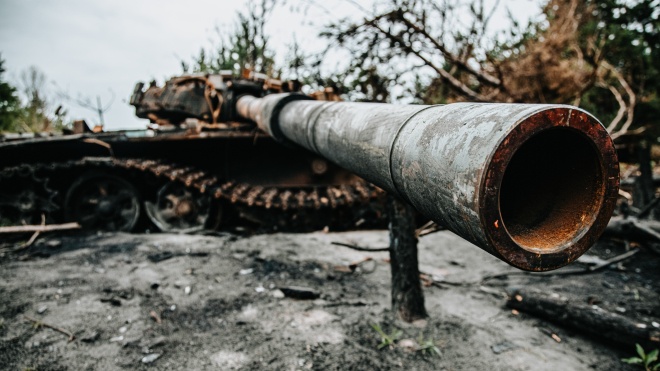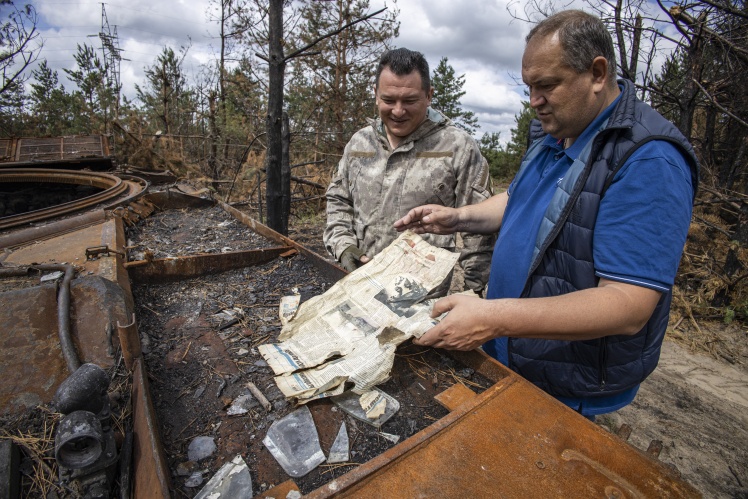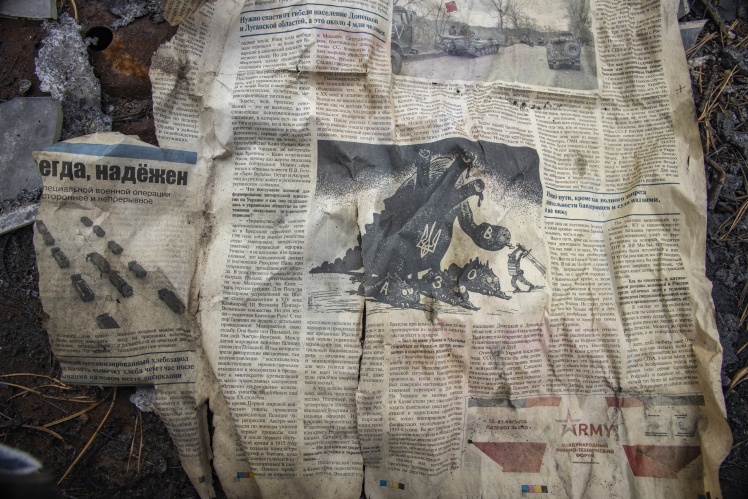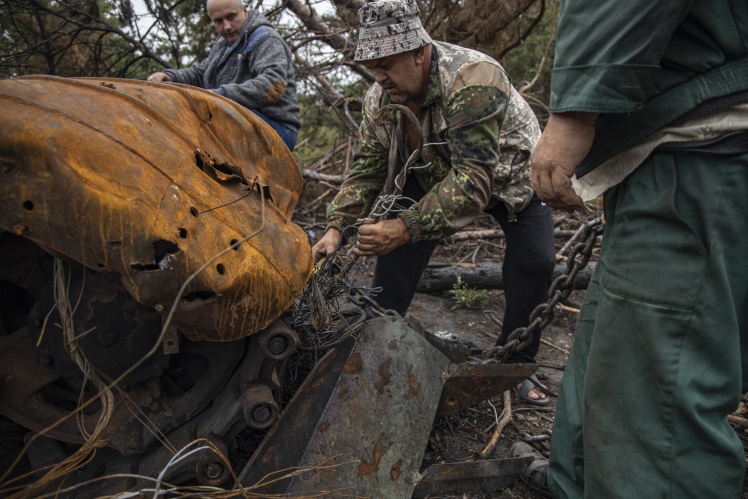1
The road from Kyiv to Berezivka has long already been cleared. What remind about the fighting are broken pine trees, smashed buildings, and dark spots on the asphalt from burned military equipment. Pavlo Netyosov knows the story of almost every such spot: he and his colleagues were one of the first to help collect the bodies of soldiers and civilians along the road in early April.
Stas Kozlyuk / «Babel'»
The car is decorated with chevrons from the inside, above the driverʼs seat are the ones with inscriptions: "Gorenka", "Hostomel". This is Pavloʼs incomplete combat geography, who on February 24 voluntarily joined the defense and liberation of Kyiv oblast. He is 48 years old, his short black hair is touched by gray here and there. Pavlo is stocky, he drives sharply and speaks clearly and to the point.
The main task for this morning is to get another exhibit from the wood line. Pavlo says tenderly — "to pull out a tankie".
Stas Kozlyuk / «Babel'»
A burned-out Russian tank stands at the exit from the main road — the Russians demolished the fence and put two tanks there. One of them, covered with black soot, is burned out completely, its tower was blown to the right, the hatch covers knocked out by an explosion from the inside. Nearby are the remains of the occupiersʼ lifestyle. A broken three-liter can of shchi, charred canning, MREs, bags from drip flasks. A crumpled Russian newspaper issued on March 15 is lying on the tank. In it is an article about the "rescue of 4 million people of Donbas" under the heading "We must go to the end!", and a little lower on the page is a hydra with the Ukrainian coat of arms, which has only its last head.
"The most important is for a tankie to be there," says Pavlo, inspecting the exhibit. “Because it happens that you arrive, and locals have already taken it to sell as scrap metal. People take everything that lies in a temptationʼs way. The state doesnʼt control this process at all.”
Stas Kozlyuk / «Babel'»
The tank together with the tower weighs 40 tons. A 70-ton crane arrives to load it on the truck. While we wait, the excavator is leveling the site so that the crane and trawl can approach the tank. Yuriy, the commander of Kolonshchynaʼs Territorial Defense, joins us. He has been helping Pavlo with the search and loading of military equipment from the very first days. A white car is parked nearby, from which two men get out. Serhiy and Valentyn are from Mykolaiv oblast, they are preparing to set up an exhibition in their city. They greet Pavlo and walk around the area together, inspecting the tank and the remains of other equipment.
Serhiy from Mykolaiv oblast is searching for exhibits for his region.
Stas Kozlyuk / «Babel'»
"You can make a showcase just from a car," says Pavlo enthusiastically. “For example, put back glass, make a door, install a light inside...”
“We will take this tank, on Thursday more equipment will come from Motyzhyn, on Monday they will bring us "Zs" from Kharkiv...” Serhiy lists.
“And we still need to find something with "O" marks. This is Chernihiv oblast, a search expedition is needed there,” adds Pavlo. He wants the exhibition to have military equipment with all the markings used by Russians.
2
When the hostilities in Kyiv oblast ended, Pavlo decided to look for the remains of Russian military equipment and everyday items for the museum.
"Our department of the museum is a department of the Ministry of Defense," says Pavlo. “And I understood that until everything was agreed [a lot of objects may get lost]... Then someone posted a photo of the plane ― I saw this tail and understood that we have to take it away, because it is aluminum, locals will take it as a scrap metal in an instant.
Stas Kozlyuk / «Babel'»
On April 26, Pavlo went to Kolonshchyna village to inspect the downed Russian Su-25 plane, but he did not know whether it would be possible to retrieve it. This time he was lucky: local Territorial Defense members and Makariv museum workers came to the plane, they also wanted to get the exhibit. After thinking about it, everyone decided to transfer it to the national museum. The locals helped pick it up and transport to the base for temporary storage, and then to Kriposny Bystreet.
Later, an armored personnel carrier, a truck, and a tank were brought there. They formed the exhibition. The Ministry of Defense joined the creation of the next one. Pavlo was offered Sikorsky Kyiv International Airport as a location. He refused, because no one would notice the exhibition there as this civilian airport is not in use in the time of hostilities. So Pavlo contacted Metropolitan Epiphanius, with whom he had already collaborated when he made the Wall of Memory, and received permission to place Russian equipment on Mykhailivska Square in front of the churchʼs cathedral.
“Some of the organizers of the exhibition were afraid of resonance. Already during the installation, passers-by said that we brought garbage to Kyiv,” says Pavlo. “But our goal is to show that the Ukrainian Armed Forces are capable of protecting and preventing enemy equipment from entering the capital.
Back in 2014, Pavlo dreamed of making an exhibition of trophy Russian equipment on Independence Square, but he did not receive the needed permission. Now, the collection and placement of equipment has permission from the Military-Civil Administration of the city and support from several ministries and the Cabinet of Ministers.
Stas Kozlyuk / «Babel'»
Pavlo emphasizes that it is important to know the limits and not turn the exposition into a show. For example, not to bring extraneous things there, as passers-by did on Mykhailivska Square. They put on the equipment womenʼs underwear, toilet lids, a skeleton in a striped vest.
“This is already a performance, and my priority is historical authenticity. We installed equipment and signs, thatʼs enough, itʼs already working,” says Pavlo. “And I think there is just enough equipment on the square now. We put a logical end to enlarging this exposition by bringing there two civilian cars used to rescue people. When Zelensky brought Boris Johnson there, I understood that we had achieved our goal.
Pavlo is sure that there will be such exhibitions throughout the country. The main thing is to have time to collect exhibits, which are already quite scarce in the de-occupied territories. In some towns and villages of Kyiv oblast, similar ones have already been made — for example, a column of tanks near Dmytrivka. He would like the exhibition from Mykhailivska Square to travel abroad and work for the benefit of Ukraine. He says that he would donate such exhibits to foreign museums — there will still be a lot of such equipment in the future, and it can be properly preserved abroad.
Stas Kozlyuk / «Babel'»
Simply collecting and bringing the artifacts is the easiest stage. Using the example of the exhibition on Mykhaylivska Square, Pavlo explains:
“Itʼs just a piece of iron. A person can touch it and feel something, but questions arise: where did the equipment come from, what happened to it and why. So we need to add a plate with detailed information. If you manage to find the Ukrainian military man who destroyed this — thatʼs great! Then we add his interview and memories via the QR code. The exhibition can be enhanced by adding details — for example, we brought shot cars of civilians to tell the story: these tanks came to destroy Ukrainians. You can also work [to create exhibitions] on the basis of documents, not the equipment.”
3
Netyosov started working with the topic of war and memory of the fallen 25 years ago. Then it was about the soldiers of the Second World War, whom he found together with the "Poshuk" club. He discovered the first human remains by accident during a hike and stopped near an old bunker. At the same time, he saw that the attitude towards the dead at official events and on non-holiday days is different, and decided to correct it. Pavlo started conducting memory lessons, did military-historical reconstructions. This continued until 2014.
In 2014, when Russia started the war, Pavlo wanted to join the volunteer battalion. But after taking the first bodies of friends from the front line, this desire vanished. When an acquaintance from the National Military Historical Museum offered to take the bodies out of the occupied territories, he agreed. That is how he became an employee of the museum and a volunteer of the "Evacuation 200" mission.
Stas Kozlyuk / «Babel'»
“We worked in the field — took out the bodies of our fallen soldiers from the occupied territory, from Savur-Mohyla, Ilovaysk, Debaltseve. This is systematic work,” remembers Netyosov.
The work lasted for three years: volunteers came from Kyiv to the front line with cargo necessary for the military, then traveled several times to the occupied territory for the bodies of the Ukrainian soldiers, stopped by for the last time to collect the exhibits — and returned to Kyiv with them and the photo archive. Those things are still in his office, among them are two sunflowers from Ilovaysk. The task is to save everything that can be saved.
Pavlo believes that several things are important now to preserve the memory of this war. First, to heroize not everyone in a row, but only those who really deserve to be honored. Secondly, to create a common story from separate personal stories. And not to look for one hero or heroine for the whole country, but to encourage cities, towns and villages to talk about their own heroes. This can be done through memory walls, renaming of streets, memorial plaques, placing flags near military graves.
“There will be no real history of Ukraine without the stories of individual people. Everything we do must be based on the truth, not embellishment. There are a lot of lies on the part of Russia," says Pavlo. “There, the cult works at an unhealthy level, they mutilate consciousness. We must work through the truth, not through coercion and fiction.”
Stas Kozlyuk / «Babel'»
Otherwise, it can happen, as with the memory of the Second World War, which in the USSR was massive in general, but often fell apart at the level of personal stories. It is not enough to rename a street in honor of a fallen soldier — you need to hang a photo, a sign, a QR code that will direct you to a story about this person, a personal page in the Book of Remembrance or other online memorials. This is already being done in Ivano-Frankivsk.
“We have to work faster. Now we are at the peak of this story,” says Pavlo, ”and based on the experience of 2015, I already know that over time the sharpness of perception will decrease. The memory of the war will not work if the commemoration is formal. And memory is vital for us. Itʼs like stabilizing a wounded person — we inject blood.”
4
While we wait for the crane to arrive, we go to the village cemetery. There, a local resident, Oleksiy, found an unknown burial.
"The grave appeared after the orcs left, none of the locals know whatʼs there," says light-haired Oleksiy. — There are also a military stretcher, two shovels, and a rope nearby. All in order to bury. They [locals] took an old cross, but nothing was written on it, only scratched on top.
While Oleksiy is talking about the grave, a grandfather appears on the road with a plastic bag in his hands. He walks along the roadside, sweeps the grass with a long aluminum probe. Gray jacket, plaid shirt, white panama. The jeans are wet up to the knees from walking through tall grass.
Stas Kozlyuk / «Babel'»
"Youʼre taking away equipment, maybe youʼll suddenly find this somewhere under a tank..." he says weakly.
“This is your son, right?” asks the commander of the local Territorial Defense Yuriy. He recognized the father of the local Territorial Defense soldier Vasyl, who went missing in March while delivering humanitarian aid.
Grandfather nods:
“Yes, yes, yes. We canʼt find him anywhere all this time. Searching and searching, searching and searching...
“Did you show the photo, Yuriy Mykolayovych?” Pavlo addresses him, flipping through pictures on his phone. “We found a man near the road sign... Now... Was he [your son] in uniform?”
“Not in uniform. He had a gray jacket, which was bright orange on the inside,” grandfather opens the flaps of his jacket, as if clarifying which color was where, so that we would not get confused.
Pavlo shows him a photo of the body that he and his brothers found. Grandpa looks on.
“No?” Yuriy asks. “You see, he has such a shape here... Exactly not?”
“No,” grandfather shakes his head in denial.
They exchange their phone numbers. Discuss unexploded shells on the roadside nearby. Grandfatherʼs hands are shaking, and the ground at his feet is in holes from the metal probe.
"Hold on," Yuriy tells him in farewell.
Grandfather once again looks into the hole nearby, and eventually goes to look for his son Vasyl further.
Pavlo believes that such a meeting is not accidental. As well as establishing the origin of a grave in a nearby cemetery. The road there runs along the broken street of Berezivka village. Near the gate itself is a trace from machinery, a broken column. Inside, old temporary crosses are leaning against the fence, which are placed on the graves until the ground settles and can withstand a heavy monument.
One of these used crosses was taken for an unknown burial in the last row. On the grave, lumps of the earth lie, not yet overgrown with grass.
Stas Kozlyuk / «Babel'»
“There is something scratched on the plate here. Above what has already been written,” Oleksiy bends over the cross in a futile attempt to recognize the numbers and letters. “It has now burned out more against the sun, two weeks ago it was much more visible...”
Meanwhile, Pavlo examines the stretcher thrown among the trees. Made in 1972, just taken out of storage. The shovels are no longer nearby, but there is a rope with which the body was probably lowered into the grave. Pavlo steps on the perimeter of the grave, and fresh earth falls through.
"Itʼs without coffin," he concludes.
“And the grave isnʼt deep,” adds Oleksiy. “Usually when thereʼs a deep pit, the earth hill above it is qiote high, and this one is small.
“Yes, this is our version,” Pavlo nods. “This is a spontaneous burial. Itʼs necessary to find out everything, to order an exhumation.”
On the way to the car, he adds that the results will not be available soon, in a few weeks — the queue for the DNA examination is too long now.
Stas Kozlyuk / «Babel'»
***
And in a week Pavlo wrote me:
"The exhumation was carried out today, in the presence of two daughters and a granddaughter of the deceased. This is a local grandmother. Orcs lived in her house, and the Ukrainian military men found her when they liberated Berezhivka, locked in a garage. They buried her."
If the forensic examination proves a violent death, the grandmotherʼs family will file a lawsuit at the European Court of Human Rights.
Translated from Ukrainian by Anton Semyzhenko.
Babel does everything to keep the memory of the war alive. Support us: donate in hryvnia 🔸 in cryptocurrency 🔸 Patreon 🔸 PayPal: [email protected]
Stas Kozlyuk / «Babel'»







